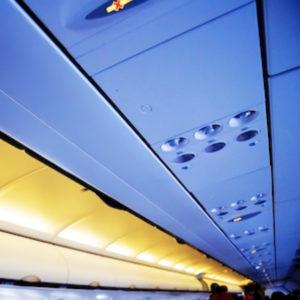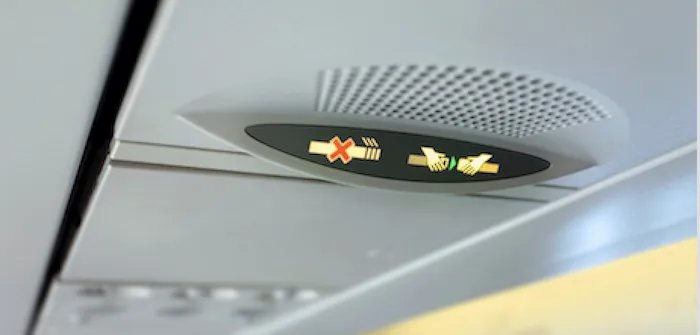Passenger and crew interaction with aircraft cabin and seating systems has become one of the most important factors in designing the onboard experience. The aircraft industry has even created and adopted its own language for the human-machine interface (HMI): PCU (Passenger Control Unit), SCU (Suite Control Unit), PBU (Privacy Button Unit), EMWS (Electro Mechanical Window Shade Switch), LMP (Lavatory Membrane Panel) – and the list goes on. The HMIs in an aircraft interior must be intuitive and integrate seamlessly into the overall design concept, both structurally and cosmetically, and nuanced effects such as backlighting and the feel of the materials used can become critical to the final design.
More ergonomic factors need to considered when designing HMIs for crew systems such as CMS (Cabin Management Systems), and the equipment used in their daily duties, for instance GAIN (Galley Insert Equipment). Space is at a premium in these areas and haptic feel can be crucial since the operational parts of galley equipment can often be hidden from the operator’s eyeline.
In the cabin areas there is often little appropriate space available on bulkheads because of the need for storage and other essential fittings. Traditionally, curved surfaces on the inside walls, mounted underneath overhead lockers or between storage units, have provided the only realistic opportunities for integrating controls and displays. But as design methods advance, curved surfaces are increasingly appearing in the seating and social environments of first and business class. Therefore conventional flat and rigid HMI and mood-lighting units have to be rethought.
The advent of smartphones and smart technologies has driven passenger demand for easy and intuitive access to entertainment system controls. HMI technology is now required to deliver the visual and haptic feedback that crew and passengers require, without need for instruction.
 Aircraft interior designers have made extensive use of secret-until-lit panel designs to ensure crew and passengers are only aware of status lights and icons when they are illuminated. A long-standing problem with traditional indicator technology used for this purpose is the amount of space required behind the panel for lamps and backlighting. If the illumination were to be made compact and light enough to integrate into seats and armrests, as well as in the bottom of overhead lockers, aircraft designers could make more extensive use of the technology.
Aircraft interior designers have made extensive use of secret-until-lit panel designs to ensure crew and passengers are only aware of status lights and icons when they are illuminated. A long-standing problem with traditional indicator technology used for this purpose is the amount of space required behind the panel for lamps and backlighting. If the illumination were to be made compact and light enough to integrate into seats and armrests, as well as in the bottom of overhead lockers, aircraft designers could make more extensive use of the technology.
The indicators may be combined with HMI technology such as membrane and capacitive touch controls in an increasingly smaller package. Light-guide technology has existed for a number of years. The conventional method of construction for the light-guide is based around a machined clear plastic part onto which are assembled LEDs, reflectors and diffusers. However, these assemblies can be clumsy and sometimes provide a less than satisfactory result in terms of brightness, homogeneousness and light bleed between graphics.
The patented low-profile backlighting technology developed by Stadium IGT makes it much easier to provide panels that can be seamlessly integrated into the aircraft design, such as the side or top of an armrest or the monument of a seat. The technology takes advantage of the same properties that make fiber-optic communication possible. Transparent materials convey light according to Fresnel’s Law of Refraction. If the light hits the surface of this transparent material at a shallow enough angle, it will reflect back into the body of the material. A larger angle lets the light escape, and the refractive index of the material determines how large this angle needs to be. Using a mixture of materials with different refractive indices, it is possible to guide light precisely to defined points.
 This approach is a radical departure from molded light-guides and demonstrates significant cost and performance benefits. The design allows multiple light guides to be integrated on a single substrate through the use of an optically transparent acrylic material. The process cuts a cavity into an opaque polymer layer into which the individually printed and laser cut acrylic optics are dispensed. This optically opaque cavity material serves to isolate adjacent light-guides, preventing any bleed from one indicator to another. Using this technique, LEDs can be placed anywhere across the light-guide substrate depending on the needs of the application, or optically coupled to the guide at the edge. The result is a light-guide with a thickness of 1.2mm or less: a significant reduction compared with traditional approaches.
This approach is a radical departure from molded light-guides and demonstrates significant cost and performance benefits. The design allows multiple light guides to be integrated on a single substrate through the use of an optically transparent acrylic material. The process cuts a cavity into an opaque polymer layer into which the individually printed and laser cut acrylic optics are dispensed. This optically opaque cavity material serves to isolate adjacent light-guides, preventing any bleed from one indicator to another. Using this technique, LEDs can be placed anywhere across the light-guide substrate depending on the needs of the application, or optically coupled to the guide at the edge. The result is a light-guide with a thickness of 1.2mm or less: a significant reduction compared with traditional approaches.
As a result, the light-guide technology provides much greater flexibility and efficiency in the mounting of LED light sources. The resulting thinness of the package construction more readily allows for the requirement for curved surfaces.
A further advantage of the technology is compatibility with capacitive sensing. With conventional display and backlighting technology, one of the major issues with integrating capacitive switches is illuminating the switch graphics – such as on/off indicators – without interfering with the electric fields needed for sensing. As the light-guide technology provides illumination from comparatively remote LEDs, there is practically no interference received by the capacitive electrodes.
The use of optics and smart manufacturing technologies, such as light guides, not only supports improved HMI designs but also ensure that HMIs meet the demands of the latest on-board experience styling concepts.
February 23, 2017
Terry Moss is sales director at Stadium IGT





